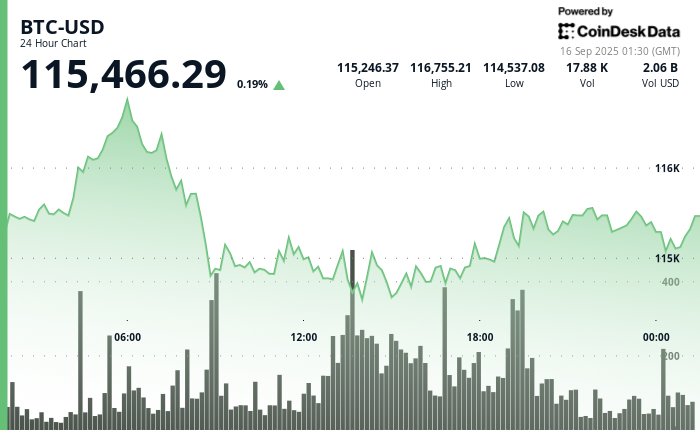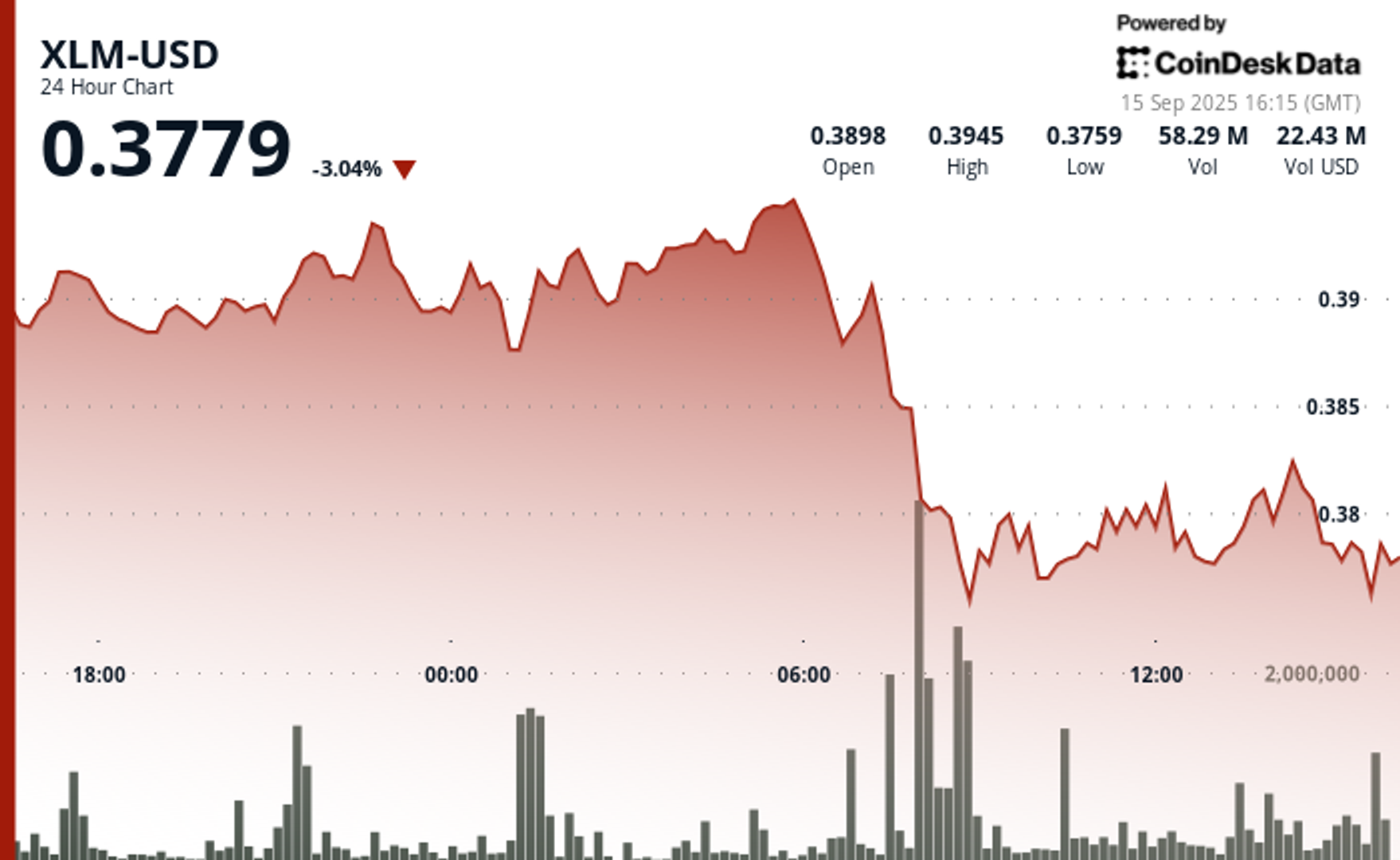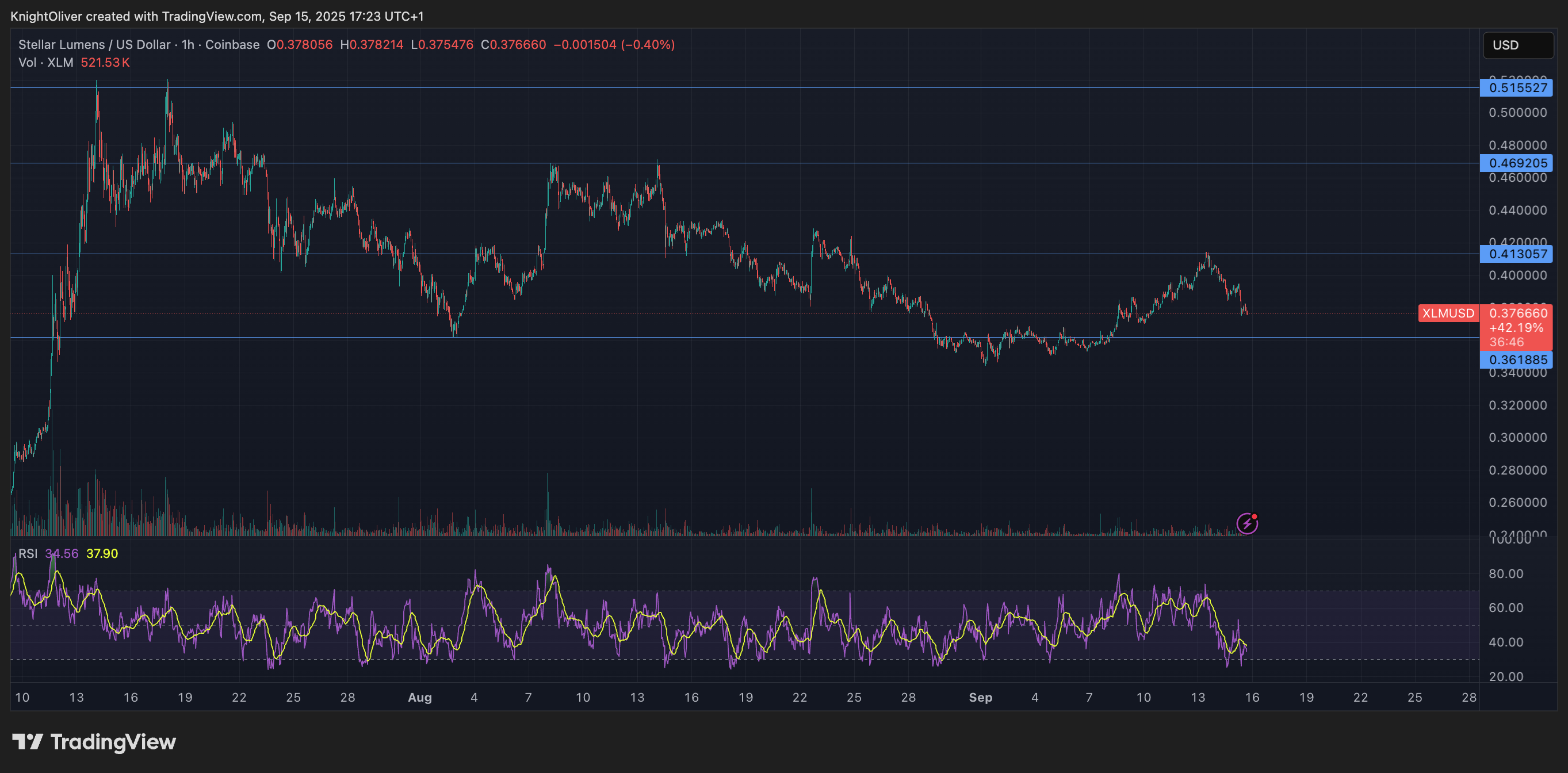Uncategorized
Crypto Daybook Americas: Bitcoin Slides to $83K as U.S. Tariffs Rattle Stocks, Currencies

By James Van Straten (All times ET unless indicated otherwise)
Liberation Day is done, and markets finally have clarity on U.S. tariffs. Starting April 5, all U.S. trading partners will face a minimum of a 10% import tariff, with higher, country-specific tariffs kicking in on April 9 for about 60 countries.
President Donald Trump introduced the tariffs based on perceived trade imbalances and non-tariff barriers, saying the goal is to encourage reshoring of production, generate revenue to help fund tax cuts and level the playing field for U.S. manufacturers.
Among the most affected countries is China, which faces a new 34% tariff on top the existing levy, bringing its total to 54%. Many other Asian economies have also been hit hard, while the European Union faces a 20% tariff.
There’s been growing interest in how the U.S. determined the tariff rates, which the administration called reciprocal. One user on X claims to have cracked the formula: Take a country’s trade deficit with the U.S. and divide it by that country’s exports to the U.S.
For example, Vietnam exports $136.6 billion to the U.S. and imports just $13.1 billion, resulting in a $123.5 billion trade deficit. When you divide the deficit by exports, you get about 90%, which aligns with the implied reciprocal tariff rate the U.S. has applied.
Global stocks are under pressure, with the Nikkei 225 losing 2.8% after dropping as much as 4.6% and the FTSE 100 losing more than 1%. Nasdaq futures are down over 3.5%. Vietnam led losses in Asia, falling 5.5% in its worst single-day drop for over four years.
The dollar weakened too, with the yen rallying to 147 against the U.S. currency and the pound to 1.31. The dollar index (DXY) fell to 102.5. Bitcoin (BTC) remains firm above $83,000, though still below its 200-day moving average of $86,400 — a key level it needs to reclaim.
The all-important U.S. 10-year Treasury yield is hovering just above 4%, the lowest level since October, which is seen as a positive for the administration in order to get interest-rates down. Stay alert!
What to Watch
Crypto:
April 5: The purported birthday of Satoshi Nakamoto.
April 9, 10:00 a.m.: U.S. House Financial Services Committee hearing about how the U.S. securities laws could be updated to take into account digital assets. Livestream link.
Macro
April 3, 8:30 a.m.: The U.S. Department of Labor releases unemployment insurance data for the week ended March 29.
Initial Jobless Claims Est. 225K vs. Prev. 224K
April 3, 9:00 a.m.: S&P Global releases Brazil March purchasing managers’ index (PMI) data.
Composite PMI Prev. 51.2
Services PMI Prev. 50.6
April 3, 9:30 a.m.: S&P Global releases Canada March purchasing managers’ index (PMI) data.
Composite PMI Prev. 46.8
Services PMI Prev. 46.6
April 3, 9:45 a.m.: S&P Global releases (Final) U.S. March purchasing managers’ index (PMI) data.
Composite PMI Est. 53.5 vs. Prev. 51.6
Services PMI Est. 54.3 vs. Prev. 51
April 3, 10:00 a.m.: Institute for Supply Management (ISM) releases U.S. March economic activity data.
Services PMI Est. 53 vs. Prev. 53.5
April 3, 10:00 a.m.: April 3, 10:00 a.m.: The U.S. Senate Banking Committee will meet in executive session to vote on the nominations of Paul Atkins as SEC chair and Jonathan Gould as comptroller of the currency. Livestream link.
April 3, 12:30 p.m.: Fed Vice Chair Philip N. Jefferson will give a speech titled “U.S. Economic Outlook and Central Bank Communications.” Livestream link.
April 4, 8:30 a.m.: Statistics Canada releases March employment data.
Unemployment Rate Est. 6.7% vs. Prev. 6.6%
April 4, 8:30 a.m.: The U.S. Bureau of Labor Statistics releases March employment data.
Nonfarm Payrolls Est. 140K vs. Prev. 151K
Unemployment Rate Est. 4.1% vs. Prev. 4.1%
April 4, 11:25 a.m.: Fed Chair Jerome H. Powell will give a speech titled “Economic Outlook.”
April 5, 12:01 a.m.: The Trump administration’s 10% baseline tariff on imports from all countries takes effect.
April 9, 12:01 a.m.: The Trump administration’s higher individualized tariffs on imports from top U.S. trade deficit countries take effect.
Earnings (Estimates based on FactSet data)
No earnings scheduled.
Token Events
Governance votes & calls
Yearn DAO is discussing a revised proposal to endorse and fund “Bearn,” a new sub-DAO for building DeFi products including a yield-backed stablecoin and a BGT liquid locker. The proposal seeks $200,000 for audit costs and $1 million in locked liquidity, offering 5% of BEARN tokens to the Yearn Treasury in return.
Lido DAO is discussing the re-endorsement of wstETH on Starknet as the canonical bridge endpoint following a completed migration from the legacy token.
April 3, 9 a.m.: SafePal, Wallet Connect and Trader to host a monthly community livestream discussing monthly updates for the projects.
April 3, 2 p.m.: Arbitrum to host an X Spaces session on real-world assets on Arbitrum.
April 3, 3 p.m.: Movement to host an X Spaces session on non-fungible tokens.
April 3, 12 p.m.: Seamless Protocol, Morpho Labs and Gauntlet to host an Ask Me Anything (AMA) session.
April 3, 12 p.m.: Wormhole to host an ecosystem call covering the latest updates and developments.
April 7, 9 a.m.: OriginTrail to host a “Shaping AI for Good” Zoom talk.
April 7, 4 p.m.: Livepeer to host a monthly community call focused on governance, funding and the strategic direction of its on-chain treasury.
Unlocks
April 3: Wormhole (W) to unlock 47.64% of its circulating supply worth $118.42 million.
April 5: Ethena (ENA) to unlock 3.25% of its circulating supply worth $55.30 million.
April 7: Kaspa (KAS) to unlock 0.59% of its circulating supply worth $9.73 million.
April 9: Movement (MOVE) to unlock 2.04% of its circulating supply worth $19.71 million.
April 12: Aptos (APT) to unlock 1.87% of its circulating supply worth $59.49 million.
Token Listings
April 3: Mantle (MNT), Vine Coin (VINE), CZ’s Dog (BROCCOLI), Moca Network (MOCA) and Nakamoto Games (NAKA) to be listed on DigiFinex.
April 3: Binance to list Gunz (GUN).
April 4: Pintu (PTU), Spartan Protocol (SPARTA), Derby Stars (DSRUN), Veloce (VEXT), BOB, and Kryptonite (SEILOR) to be deslisted from Bybit.
Conferences
CoinDesk’s Consensus is taking place in Toronto on May 14-16. Use code DAYBOOK and save 15% on passes.
Day 2 of 2: Southeast Asia Blockchain Week 2025 Main Conference (Bangkok)
Day 2 of 4: ETH Bucharest Conference & Hackathon (Romania)
Day 1 of 4: BitBlockBoom (Dallas)
April 6-9: Hong Kong Web3 Festival
April 8-10: Paris Blockchain Week
April 10: Bitcoin Educators Unconference (Nashville)
April 15-16: BUIDL Asia 2025 (Seoul)
April 22-24: Money20/20 Asia (Bangkok)
April 23: Crypto Horizons 2025 (Dubai)
April 23-24: Blockchain Forum 2025 (Moscow)
April 24: Bitwise’s Investor Day for Bitcoin Standard Corporations (New York)
Token Talk
By Shaurya Malwa
Treasure DAO, a decentralized video-game ecosystem, is restructuring to extend its financial runway to February 2026, with chief contributor John Patten resuming a leadership role and proposing a plan to streamline operations, cut costs, and focus on four key products: marketplace, Bridgeworld, Smolworld and AI agent.
As part of cost-cutting measures, 15 contributors have left or been laid off, Patten said in a video posted on X, and game publishing support and the treasure chain will be terminated.
He further proposed withdrawing $785,000 from Flowdesk to increase the DAO’s treasury, which currently holds $2.4 million and 22.3 million MAGIC tokens valued at $2.3 million.
Patten warned that with the current burn rate of $8.3 million annually and a potential decline in MAGIC’s value, the DAO could become unsustainable between December 2025 and February 2026 without these changes.
Derivatives Positioning
BTC, ETH basis on the CME and offshore exchanges is holding at around an annualized 5% after the overnight sell-off.
XRP, BNB and SOL are seeing negative funding rates in a sign of renewed bias for bearish, short bets, according to data source Velo.
XRM, BTC and OM stand out with positive cumulative volume deltas hinting at net buying in the past 24 hours.
The bearish mood in Deribit’s BTC and ETH options now extends out to the end of June as opposed to May before the U.S. tariff announcement.
Market Movements
BTC is down 2.17% from 4 p.m. ET Wednesday at $83,799.17 (24hrs: -1.62%)
ETH is down 1.93% at $1,844.66 (24hrs: -3.15%)
CoinDesk 20 is down 0.56% at 2,559.88 (24hrs: -0.07%)
Ether CESR Composite Staking Rate is down 8 bps at 3.02%
BTC funding rate is at 0.0047% (5.0983% annualized) on Binance

DXY is down 1.66% at 102.09
Gold is up 0.32% at $3,149.9/oz
Silver is down 4.14% at $33.07/oz
Nikkei 225 closed -2.77% at 34,735.93
Hang Seng closed -1.52% at 22,849.81
FTSE is down 1.33% at 8,494.33
Euro Stoxx 50 is down 2.13% at 5,191.06
DJIA closed on Wednesday +0.56% at 42,225.32
S&P 500 closed +0.67% at 5670.97
Nasdaq closed +0.87% at 17,601.05
S&P/TSX Composite Index closed +1.09% at 25,307.20
S&P 40 Latin America closed +0.3% at 2,448.23
U.S. 10-year Treasury rate is down 7 bps at 4.05%
E-mini S&P 500 futures are down 3.05% at 5,538.00
E-mini Nasdaq-100 futures are down 3.3% at 19,105.25
E-mini Dow Jones Industrial Average Index futures are down 2.53% at 41,416.00
Bitcoin Stats:
BTC Dominance: 62.86 (0.13%)
Ethereum to bitcoin ratio: 0.02176 (0.05%)
Hashrate (seven-day moving average): 835 EH/s
Hashprice (spot): $47.31
Total Fees: 4.43 BTC / $377,634
CME Futures Open Interest: 138,385 BTC
BTC priced in gold: 26.5 oz
BTC vs gold market cap: 7.53%
Technical Analysis

Solana’s SOL token dropped below $125, which acted as demand zone several times last year.
The breakdown of the key support signals continuation of the downtrend, with the next support at $100 followed by $78, the January 2024 low.
Crypto Equities
Strategy (MSTR): closed on Wednesday at $312.54 (+2.13%), down 4.69% at $297.89 in pre-market
Coinbase Global (COIN): closed at $182.95 (+4.83%), down 5.49% at $172.90
Galaxy Digital Holdings (GLXY): closed at C$17.10 (+4.72%)
MARA Holdings (MARA): closed at $12.42 (+4.9%), down 6.28% at $11.64
Riot Platforms (RIOT): closed at $8.02 (+6.37%), down 5.61% at $7.57
Core Scientific (CORZ): closed at $8.42 (+5.25%), down 6.18% at $7.90
CleanSpark (CLSK): closed at $8.02 (+6.08%), down 7.11% at $7.45
CoinShares Valkyrie Bitcoin Miners ETF (WGMI): closed at $14.24 (+4.17%)
Semler Scientific (SMLR): closed at $37.03 (+1.4%)
Exodus Movement (EXOD): closed at $47.33 (+3.73%), down 0.72% at $46.99
ETF Flows
Spot BTC ETFs:
Daily net flow: $218.1 million
Cumulative net flows: $36.33 billion
Total BTC holdings ~ 1.12 million.
Spot ETH ETFs
Daily net flow: -$51.3 million
Cumulative net flows: $2.38 billion
Total ETH holdings ~ 3.42 million.
Source: Farside Investors
Overnight Flows

Chart of the Day

Traders on decentralized prediction platform Polymarket now see an above-50% chance of the U.S. economy slipping into a recession this year.
The outlook may weigh on risky assets in the short-term.
While You Were Sleeping
U.S. Recession Odds Surge in Prediction Markets on Tariff Shock. What Next for BTC? (CoinDesk): Recession odds on Kalshi and Polymarket jumped above 50% after the tariff announcement, sending U.S. stock futures and bitcoin lower on trade war fears.
Bitcoin Nears Death Cross, Yuan Tumbles With Asian Markets After Trump Tariffs Put Focus on China’s Response (CoinDesk): Asian equities and U.S. stock futures declined, while bitcoin approached a bearish technical pattern amid escalating trade tensions.
XRP in Focus as RLUSD Sees $100M Minted on Ripple Payments Boost (CoinDesk): Ripple’s RLUSD stablecoin saw increased issuance this week following its addition to the company’s payments platform.
Trump’s ‘Reciprocal’ Tariff Formula Is All About Trade Deficits (Bloomberg): The White House said the individualized reciprocal tariffs were set by halving each country’s 2024 trade surplus with the U.S. as a share of its exports.
EU’s Von Der Leyen Vows Response to Trump’s 20% Tariffs (The Wall Street Journal): Von Der Leyen said the bloc is finalizing a response to steel tariffs and warned further retaliatory measures were in the works if talks with the U.S. fail.
‘Absolutely Nothing Good’ Coming out of Trump’s Tariff Announcement: Analysts React to Latest U.S. Levies (CNBC): Analysts warned Trump’s sweeping tariffs could spark stagflation, damage global growth and drive the U.S. into recession, with some noting the measures rival 1930s-era trade barriers.
China Urges U.S. to Immediately Lift Tariffs, Vows Retaliation (Reuters): China’s Commerce Ministry said the U.S. tariffs ignore past multilateral trade agreements and overlook how much Washington has historically gained from global commerce.
In the Ether





Uncategorized
Asia Morning Briefing: Fragility or Back on Track? BTC Holds the Line at $115K

Good Morning, Asia. Here’s what’s making news in the markets:
Welcome to Asia Morning Briefing, a daily summary of top stories during U.S. hours and an overview of market moves and analysis. For a detailed overview of U.S. markets, see CoinDesk’s Crypto Daybook Americas.
Bitcoin (BTC) traded just above $115k in Asia Tuesday morning, slipping slightly after a strong start to the week.
The modest pullback followed a run of inflows into U.S. spot ETFs and lingering optimism that the Federal Reserve will cut rates next week. The moves left traders divided: is this recovery built on fragile foundations, or is crypto firmly back on track after last week’s CPI-driven jitters?
That debate is playing out across research desks. Glassnode’s weekly pulse emphasizes fragility. While ETF inflows surged nearly 200% last week and futures open interest jumped, the underlying spot market looks weak.
Buying conviction remains shallow, Glassnode writes, funding rates have softened, and profit-taking is on the rise with more than 92% of supply in profit.
Options traders have also scaled back downside hedges, pushing volatility spreads lower, which Glassnode warns leaves the market exposed if risk returns. The core message: ETFs and futures are supporting the rally, but without stronger spot flows, BTC remains vulnerable.
QCP takes the other side.
The Singapore-based desk says crypto is “back on track” after CPI confirmed tariff-led inflation without major surprises. They highlight five consecutive days of sizeable BTC ETF inflows, ETH’s biggest inflow in two weeks, and strength in XRP and SOL even after ETF delays.
Traders, they argue, are interpreting regulatory postponements as inevitability rather than rejection. With the Altcoin Season Index at a 90-day high, QCP sees BTC consolidation above $115k as the launchpad for rotation into higher-beta assets.
The divide underscores how Bitcoin’s current range near $115k–$116k is a battleground. Glassnode calls it fragile optimism; QCP calls it momentum. Which side is right may depend on whether ETF inflows keep offsetting profit-taking in the weeks ahead.

Market Movement
BTC: Bitcoin is consolidating near the $115,000 level as traders square positions ahead of expected U.S. Fed policy moves; institutional demand via spot Bitcoin ETFs is supporting upside
ETH: ETH is trading near $4500 in a key resistance band; gains are being helped by renewed institutional demand, tightening supply (exchange outflows), and positive technical setups.
Gold: Gold continues to hold near record highs, underpinned by expectations of Fed interest rate cuts, inflation risk, and investor demand for safe havens; gains tempered somewhat by profit‑taking and a firmer U.S. dollar
Nikkei 225: Japan’s Nikkei 225 topped 45,000 for the first time Monday, leading Asia-Pacific gains as upbeat U.S.-China trade talks and a TikTok divestment framework lifted sentiment.
S&P 500: The S&P 500 rose 0.5% to close above 6,600 for the first time on Monday as upbeat U.S.-China trade talks and anticipation of a Fed meeting lifted stocks.
Elsewhere in Crypto
Uncategorized
Wall Street Bank Citigroup Sees Ether Falling to $4,300 by Year-End

Wall Street giant Citigroup (C) has launched new ether (ETH) forecasts, calling for $4,300 by year-end, which would be a decline from the current $4,515.
That’s the base case though. The bank’s full assessment is wide enough to drive an army regiment through, with the bull case being $6,400 and the bear case $2,200.
The bank analysts said network activity remains the key driver of ether’s value, but much of the recent growth has been on layer-2s, where value “pass-through” to Ethereum’s base layer is unclear.
Citi assumes just 30% of layer-2 activity contributes to ether’s valuation, putting current prices above its activity-based model, likely due to strong inflows and excitement around tokenization and stablecoins.
A layer 1 network is the base layer, or the underlying infrastructure of a blockchain. Layer 2 refers to a set of off-chain systems or separate blockchains built on top of layer 1s.
Exchange-traded fund (ETF) flows, though smaller than bitcoin’s (BTC), have a bigger price impact per dollar, but Citi expects them to remain limited given ether’s smaller market cap and lower visibility with new investors.
Macro factors are seen adding only modest support. With equities already near the bank’s S&P 500 6,600 target, the analysts do not expect major upside from risk assets.
Read more: Ether Bigger Beneficiary of Digital Asset Treasuries Than Bitcoin or Solana: StanChart
Uncategorized
XLM Sees Heavy Volatility as Institutional Selling Weighs on Price

Stellar’s XLM token endured sharp swings over the past 24 hours, tumbling 3% as institutional selling pressure dominated order books. The asset declined from $0.39 to $0.38 between September 14 at 15:00 and September 15 at 14:00, with trading volumes peaking at 101.32 million—nearly triple its 24-hour average. The heaviest liquidation struck during the morning hours of September 15, when XLM collapsed from $0.395 to $0.376 within two hours, establishing $0.395 as firm resistance while tentative support formed near $0.375.
Despite the broader downtrend, intraday action highlighted moments of resilience. From 13:15 to 14:14 on September 15, XLM staged a brief recovery, jumping from $0.378 to a session high of $0.383 before closing the hour at $0.380. Trading volume surged above 10 million units during this window, with 3.45 million changing hands in a single minute as bulls attempted to push past resistance. While sellers capped momentum, the consolidation zone around $0.380–$0.381 now represents a potential support base.
Market dynamics suggest distribution patterns consistent with institutional profit-taking. The persistent supply overhead has reinforced resistance at $0.395, where repeated rally attempts have failed, while the emergence of support near $0.375 reflects opportunistic buying during liquidation waves. For traders, the $0.375–$0.395 band has become the key battleground that will define near-term direction.

Technical Indicators
- XLM retreated 3% from $0.39 to $0.38 during the previous 24-hours from 14 September 15:00 to 15 September 14:00.
- Trading volume peaked at 101.32 million during the 08:00 hour, nearly triple the 24-hour average of 24.47 million.
- Strong resistance established around $0.395 level during morning selloff.
- Key support emerged near $0.375 where buying interest materialized.
- Price range of $0.019 representing 5% volatility between peak and trough.
- Recovery attempts reached $0.383 by 13:00 before encountering selling pressure.
- Consolidation pattern formed around $0.380-$0.381 zone suggesting new support level.
Disclaimer: Parts of this article were generated with the assistance from AI tools and reviewed by our editorial team to ensure accuracy and adherence to our standards. For more information, see CoinDesk’s full AI Policy.
-

 Business11 месяцев ago
Business11 месяцев ago3 Ways to make your business presentation more relatable
-

 Fashion11 месяцев ago
Fashion11 месяцев agoAccording to Dior Couture, this taboo fashion accessory is back
-

 Entertainment11 месяцев ago
Entertainment11 месяцев ago10 Artists who retired from music and made a comeback
-

 Entertainment11 месяцев ago
Entertainment11 месяцев ago\’Better Call Saul\’ has been renewed for a fourth season
-

 Entertainment11 месяцев ago
Entertainment11 месяцев agoNew Season 8 Walking Dead trailer flashes forward in time
-

 Business11 месяцев ago
Business11 месяцев ago15 Habits that could be hurting your business relationships
-

 Entertainment11 месяцев ago
Entertainment11 месяцев agoMeet Superman\’s grandfather in new trailer for Krypton
-

 Entertainment11 месяцев ago
Entertainment11 месяцев agoDisney\’s live-action Aladdin finally finds its stars





